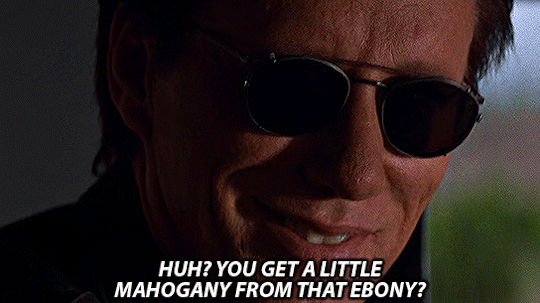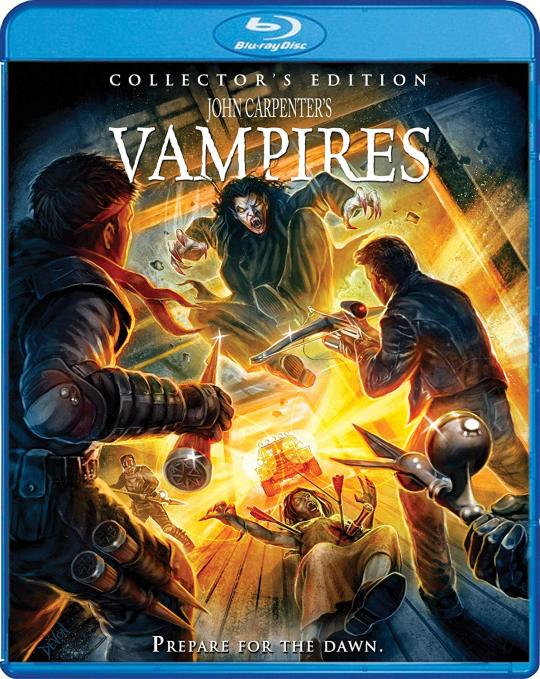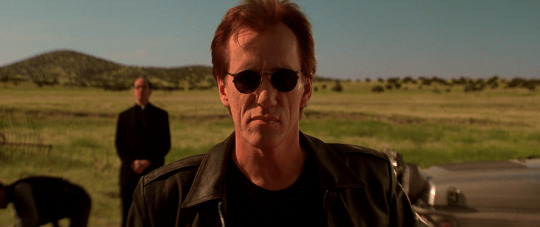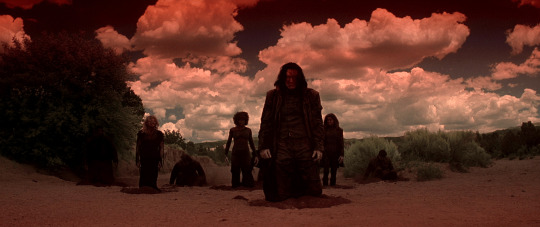#Father Adam Guiteau
Photo






Vampires (1998) // Dir. John Carpenter
#Vampires#Vampires 1998#John Carpenter#James Woods#Jack Crow#Father Adam Guiteau#Father Guiteau#Adam Guiteau#Tim Guinee#Horror#Vampires Gifs#Gifs#Movie#Movie Gifs#AVMovie#AVMovieGifs#AVGifs#AVVampires#AVVampiresGifs
42 notes
·
View notes
Text
Death Kiss
Status: COMPLETE
Bishop Losa, Reyes brothers and Ocs | Mayans x Vampire (1998)

A mini fic | part of Frightfest | ✨✨A03 story link ✨✨| moodboards | Moodboards
Previews - tumblr main and @artemiseamoon-updates | Full works post to A03
Summary
Blu and the Sugarplums are hired for a private party that turns deadly. In the aftermath of blood and death, the survivors team up with vampire hunters for survival.
Overall warnings
vampire stuff, some gore, sexual situations, deaths, a person gets held up and their car stolen but w/o any physical violence (not diminishing how shitty that act is, but in case anyone is sensitive to that, know there is no violent act involved) accidents (like a car crashing)
Characters
There are a few, so below is a key if you need it, or to come back to it as you read.
Bishop and the Reyes Brothers
Their team of vampire hunters (only some mentioned by name like Jim, Chris )
My Ofcs: Blu and Luz (Blu is 38, Lux is 27)
The Sugarplums aka the working ladies, there are about 10 of them (only some mentioned by name like Luz, Hazel, Candy)
Side characters: Father Adam Guiteau, Sheriffs (Sheriff Perry), Deputies (Deputy Kyle), etc. , Father Gio
Mayans note
I did not have the heart to kill a bunch of the Mayans guys, I love them too much. So I am just using Bishop and the Reyes Brothers for this, the rest of their team is filled with made up side characters.
Tumblr previews (a03 links included)
Read directly on A03
Chapter one: sugarplum and blood
Chapter two: a place to lay low
Chapter three: it’s starting
Chapter four: welcome to the team sweetheart
Chapter five: end of the line
Chapter six: no going back


My main Oc, Blu

#bishop losa#ez reyes#Angel Reyes#Mayans Mc#vampire hunters#fic: death kiss#black original character#black ofc#bishop x black ofc
22 notes
·
View notes
Text
My husband and I don't watch movies the same way anymore... us sitting here watching John Carpenter's Vampires and shipping Jack and Father Adam Guiteau.
2 notes
·
View notes
Text
Blu-ray Review: Vampires

John Carpenter is an undisputed master of horror, having helmed such classics as Halloween, The Thing, The Fog, and Christine, but he always wanted to make a Western. While he explored Western themes into Assault on Precinct 13, Escape from New York, and Big Trouble in Little China, he didn't get the opportunity to fully immerse himself in the genre until 1998's Vampires. Trading cowboys and Native Americans for vampires and vampire hunters, the neo-Western concept allowed Carpenter to combine his interest in Westerns with his penchant for horror.
Set in a world in which vampires have existed for hundreds of years unbeknownst to the general public, James Woods (Videodrome) stars as Jack Crow, who was raised by the Catholic church to be the ultimate vampire mercenary. He leads a Wild Bunch-esque team that slays bloodsuckers by day and parties like rock stars come nightfall - that is until the gang is mercilessly slaughtered by a master vampire known as Jan Valek (Thomas Ian Griffith, The Karate Kid Part III), the likes of which no one has ever seen.

The only person to face Valek and survive, Crow regroups with his right-hand man, Anthony Montoya (Daniel Baldwin, Mulholland Falls), a church-appointed liaison, Father Adam Guiteau (Tim Guinee, Blade), and a would-be one-night-stand, Katrina (Sheryl Lee, Twin Peaks), who was bitten during the vampire attack. As the master shares a telepathic link with its underlings, Crow is quick to utilize Katrina to track Valek before she completes her transformation into the undead.
Based on John Steakley’s 1990 novel, Vampire$, and adapted by screenwriter Don Jakoby (Arachnophobia), the plot of Vampires is more complicated than it needs to be, but it never feels hindered by exposition. While the Western angle may have attracted Carpenter to the project, the script lends itself to several set pieces that allow him to play to his strengths in horror as well as action, from the Gothic atmosphere of the opening sequence to the vicious vampire effects by KNB EFX Group (From Dusk Till Dawn, Scream).

Woods is not the first actor to come to mind when you think of grizzled antiheroes. With a sarcastic sense of humor injected into the sparse dialogue, the role feels tailor-made for frequent Carpenter collaborator Kurt Russell, but Woods proves to wear the leather jacket well. In a time when such larger-than-life roles were dominated by muscleheads like Arnold Schwarzenegger and Sylvester Stallone, the part harkens back to the days of Clint Eastwood, Charles Bronson, and Henry Ford. Woods reportedly ad-libbed some of his silver-tongued dialogue, which adds more personality to the character, but sadly results in some homophobic dialogue.
Lee is a captivating presence on screen, but her role is a thankless one. The only female character of note, she's treated more like a prop than an actor as she is constantly pushed around both literally and metaphorically. Baldwin has had well-publicized battles with personal demons, but he's in top form here, playing well off of Woods with his tough guy persona. Griffith has the commending presence necessary to play the ultimate vampire, able to come off as both savage and suggestive - although, as the story dictates, he often leans toward the former. The cast also includes Maximilian Schell (Judgment at Nuremberg), Mark Boone Junior (Sons of Anarchy), Gregory Sierra (Barney Miller), Cary-Hiroyuki Tagawa (Mortal Kombat), and a cameo from filmmaker Frank Darabont (The Shawshank Redemption).

Carpenter and his frequent director of photographer, Gary B. Kibbe (They Live, Ghosts of Mars), utilize wide, anamorphic shots that evoke the director's early work as well as Sergio Leone's classic Spaghetti Westerns. The Western aesthetic is echoed by the soundtrack, on which Carpenter collaborated with Booker T. & the M.G. guitarist Steve Cropper and bassist Donald "Duck" Dunn and former The Doobie Brothers and Steely Dan guitarist Jeff Baxter. The score mixes Carpenter's traditional, sinister synthesizer cues with bluesy rock and southern-fried guitar licks.
Scream Factory has released Vampires as a Collector's Edition Blu-ray. It offers Sony's same transfer that was used for Twilight Time's sold-out 2015 limited edition release of the film, which is pristine. The sun-baked orange glow of the desert (shot on location in Santa Fe, New Mexico) is particularly striking in high definition. The release features fiery new cover art byDevon Whitehead, along with the original poster on the reverse side.

The real selling point is the new extras. A 12-minute piece edits together new interviews with Carpenter, producer (and Carpenter's wife) Sandy King, and Kibbe. They discuss the making-of the film, its themes, the cast, and even the sequel, but it really only scratches the surface. An unexpectedly lively interview with Woods offers more substance. While he admits he wasn't the action hero prototype, the 22-minute chat makes it apparent that he relished the opportunity to play one. There are also new interviews with Griffith, who reminisces about being buried alive; Guinee, who shares a humorous fart story; and special effects artist Greg Nicotero, who breaks down several of the film's impressive effects sequences.
Carpenter's DVD audio commentary is ported over. Always significantly more animated when joined by a cast member, the director’s track isn't particularly informative, but he does share a handful of anecdotes between pauses and explaining what's happening on the screen. Carpenter shines more on the isolated score track that is also included. Archival extras include the vintage, 6-minute making-of featurette, along with extended segments with Carpenter, Woods, Baldwin, and Lee, plus B-roll footage from the shoot. There's also the trailer, TV spots, and a still gallery.
Vampires will be released on Blu-ray on September 24 via Scream Factory.
#vampires#john carpenter#james woods#william baldwin#sheryl lee#scream factory#dvd#gift#article#review#devon whitehead#john carpenter's vampires#greg nicotero#mark boone junior#vampire$
28 notes
·
View notes
Text
Five Reasons John Carpenter’s VAMPIRES Still Matters 20 Years Later
Vampires was released twenty years ago and was an important film for a multitude of reasons. It took the number 1 spot opening weekend. Despite breaking even in the domestic box office, worldwide gross saw Vampires double its budget – making it John Carpenter’s only successful film at the box office during the 90’s. It went on to win 3 Saturn Awards for Best Actor, Best Music and Best Make-up. Audiences clamored to see Jack Crow and his team of hunters track down an ancient evil.
John Carpenter’s Vampires follows our main protagonist, Jack Crow, who is a master vampire slayer raised and trained by the Catholic Church. Driven by a haunted past and a thirst for vengeance, Jack sets out with his team to rid the world of the bloodsucking menace. Despite his team’s affiliation with the church, they use ruthless methods that are just as savage as the creatures they hunt. Father Adam Guiteau accompanies Jack’s team on their journey, lending his knowledge to their repertoire. Tension between the team threatens them all, but with their combined skills they begin to close in on their target. They discover Valek’s sinister plan, it’s a race against time with the fate of humanity hanging in the balance.
Twenty years later Vampires still has a cult following, and here’s five reasons why.
youtube
5. The Cast and Crew Gave a Stellar Performance
James Woods gives an amazing performance as Jack Crow, emphasized by the freedom he was given with the role. He plays the foul-mouthed, vengeful leader effortlessly. Accompanied by a supporting cast of Daniel Baldwin, Sheryl Lee, and Tim Guinee, we get quite the rag-tag bunch of protagonists in opposition to lead villain (and vampire), Thomas Ian Griffith. Other notable appearances include Mark Boone Junior and Frank Darabont.
In terms of the crew – the trio of Greg Nicotero, Robert Kurtzman and Howard Berger brought award winning special effects makeup to the film as KNB EFX. And, Although it goes without saying, having horror legend John Carpenter helming the project brought it all together. From his keen eye for horror, to his skillful atmospheric manipulation, he brought Vampires to life. Lastly, his work as a composer benefits the film as it does all of his work.
4. Vampires Skillfully Blurs Genre Lines
Despite vampires being a more ‘gothic’ staple of the horror genre, John Carpenter’s Vampires veers towards a more western action-film approach. This blending of genres is in part why Carpenter undertook the project. In the audio commentary, he mentions the resemblance of a western film being what initially caught his eye. At times the fight scenes and fiery effects can have you thinking you’re watching a straight action flick. Then we’re drawn right back to the realm of traditional horror through the film’s brutal bloodbaths and supernatural scenes. Just as tension peaks, it’s broken with quick quips and lewd humor making for a rollercoaster of a ride. All this set in a western film paradigm shows how artfully Carpenter can blur genre lines. This truly helps to set the film apart from its straight horror brethren.
3. No Coffins Lines in Taffeta Here..
Valek and his minions aren’t your typical vampires. While most films of the time feature vampires that were either ‘the lone aristocrat in the castle‘ stereotype or the ‘brooding creature of the night‘, in Vampires we received a breath of fresh air – with brutal bloodsuckers that are equally cunning and cruel. Valek especially is ruthless in both his actions and words. These vampires skip subtlety, going straight for the jugular as they savagely slay anyone who stands in their way. Foregoing lavish clothing and the luxurious coffins, these creatures nest together and aren’t afraid of getting a little dirty. The savage nature of these bloodsuckers makes John Carpenter’s Vampires one of my favorites of the sub-genre.
2. Vampires Doesn’t Shy Away from the Bloody Details
While it’s true that there can be power in subtlety, it’s not always the best approach. Sure, one show the vampire feeding off-screen, coming back only to wipe a stray drop of blood from his lip. This is fine for the gothic approach, but Carpenter wanted something more visceral. Vampires forgoes this and shows the gory mess by the bucketful. So much so that the MPAA threatened it with an NC-17 rating. Ultimately, a few seconds had to be cut and a few gruesome acts left unseen to achieve an R rating. Fortunately they kept the vast majority of it intact, allowing us to see Vampires as John Carpenter intended.
1. Vampires is a Fun Film That Doesn’t Take Itself Too Seriously
With undertaking a film that tiptoes between genres it could have been easy for the film to take itself too seriously. Vampires could have been a tale of a cowboy-esque slayer that was all business, and ultimately, forgettable. Instead, Vampires knows when to take itself seriously, and when to pull back and give a cheap laugh or two. Its all about balance. We get the action, we get the laughs and we get the gore. Overall we get an entertaining watch that’s worth the time.
These are the reasons Vampires is still killing it, 20 years later. Though it isn’t the most genre defining film of its kind – it doesn’t need to be. What is important is that Vampires is fun. It took risks crossing genres and breaking from previously established norms. It brought us vampires that think and act like the superior predators they are instead of just arrogant aristocrats. Twenty years later, Vampires is still an important entry in the ever-growing list of vampire films.
Let us know your thoughts on John Carpenter’s Vampires over in our Facebook Group, or new Subreddit!
The post Five Reasons John Carpenter’s VAMPIRES Still Matters 20 Years Later appeared first on Nightmare on Film Street - Horror Movie Podcast, News and Reviews.
from WordPress https://nofspodcast.com/john-carpenters-vampires-turns-20/
via IFTTT
3 notes
·
View notes
Text
A brief history of the United States by President
Revolutionary
1. George Washington (1789-1797)
-Founding Father; served as Commander in Continental Army during the American Revolution.
-Established system of taxation & National Bank.
-First term largely preoccupied with capturing Ohio Country through irregular (ranger) warfare.
2. John Adams (1797-1801)
-Another Founding Father; Leader in the movement for American Independence.
-Fierce criticism from Jeffersonian Republicans; rivals with Alexander Hamilton.
-Passed Alien & Sedition Acts making it harder for immigrants to become citizens.
3. Thomas Jefferson (1801-1809)
-Founding Father; Principle author of the Declaration of Independence.
-Louisiana Purchase doubling country’s territory - involved Indian Removal policy.
-Act Prohibiting Importation of Slaves in 1807 (but owned hundreds); domestic slave trade still allowed, and slaves also continued to be imported in limited numbers.
-Lewis & Clark expedition to explore Louisiana Territory and gain intelligence on Indigenous nations; Pike Expedition to present-day Colorado to gain intelligence on Mexico.
-Invasion of Barber nation in North Africa against pirate attacks on US merchant ships.
4. James Madison (1809-1817)
-Founding Father hailed as “Father of the Constitution” and Bill of Rights (drafted first 10 amendments).
-Led US into War of 1812 over British trade restrictions - peace in 1815 with no boundary changes.
-Ohio Country war still waging, along with war against Muskogee Nation in South 1813-14, culminating in elimination of Indigenous powers east of the Mississippi.
5. James Monroe (Era of Good Feelings) (1817-1825)
-Last President who was a Founding Father.
-Sent Jackson to Florida to fight in first Seminole War and retrieve runaway slaves (1818).
-Ratified Adams-Onis Treaty of 1819, buying Florida from Spain and extending US to the Pacific (with Southern border running through Sabine River/Rocky Mountains).
-Monroe Doctrine policy of opposing European colonialism & intervention in the Americas.
-Office of Indigenous Affairs established in 1824 (within the Department of War for the first 25 years).
6. John Quincy Adams (1825-1829)
-With high tariffs got rid of most national debt, pushed for road & canal construction.
-Easy foreign policy because of his eight proceeding years as Secretary of State.
-Semi-tried to defend Native Americans on the frontier.
Jacksonian
7. Andrew Jackson (1829-1837)
-Beginning of spoils system in US politics.
-Fought against Muskogees and in Seminole Wars (an Everglade-area nation born of resistance to colonizers) before administration - as president, waged Second Seminole war in attempt to get Seminoles to leave FL altogether.
-Indian Removal Act 1830 (Trail of Tears) forcibly relocated many tribes from the South to Oklahoma.
-86 treaties with 26 Indigenous nations between New York and Mississippi forcing land sessions and removals during Jacksonian era.
-Supreme Court ruled in favor of Cherokees keeping their land in Georgia; Jackson ignored them.
-Collaborated with South to keep abolitionist literature out of the mail.
8. Martin Van Buren (1837-1841)
-Blamed at the time for the Panic (depression) of 1837.
-1838 US Army’s forced march of Cherokee Nation from Georgia/Alabama to northern Oklahoma during the dead of winter; half of the entire Cherokee population died - originating term Trail of Tears.
-Denied the application of Texas for admission to the Union - didn’t want to upset balance of slave versus free states; didn’t want to upset Mexico (who still need not recognize TX independence).
-Increasingly abolitionist later in life post-presidency.
9. William Henry Harrison (31 days in 1841)
-Elected president largely based on success in battle of Tippecanoe, stealing Indigenous land in Indiana in 1811.
-Died of pneumonia, running mate John Tyler took his place (first president to die in office).
10. John Tyler (1841-1845)
-Firm believer in Manifest Destiny, territorial expansion included negotiating the annexation of the independent Republic of Texas (final process carried out by his successor Polk).
-Originally chosen as Whig VP to increase voter base; did not have support of either Democratic or Whig parties; presidency viewed in low consequence/esteem by historians.
11. James K. Polk (1845-1849)
-Acquired land in Oregon territory (from British occupiers) and finalized process of annexation of Texas (increasing tensions with Mexico).
-As direct consequence, began the Mexican-American War 1846-1848, ending in Treaty of Guadalupe Hidalgo and establishing current US-Mexico border. Gold rush to California began directly following.
12. Zachary Taylor (1849-1850)
-Working to establish statehood and borders of California, Utah, New Mexico and Texas - which also involved disputes over slavery.
-Died after falling ill from eating excessive raw fruit & ice milk at a presidential event for Fourth of July.
13. Millard Fillmore (1850-1853)
-As Taylor’s VP assumed position when he died.
-Compromise of 1850 admitted California as new state, decided borders between Utah, NM, TX, and which of those would be allowed slaves, included Fugitive Slave Act which required escaped slaves even in free states to be turned in to their masters if found out; temporarily eased tensions between North & South.
Civil War & Reconstruction
14. Franklin Pierce (1853-1857)
-Kansas-Nebraska Act created new official territories, leading to new disputes between pro- and anti-slavery forces. Settlers from both sides flooded the areas to influence politics.
-Enforcement of the Fugitive Slave Act angered Free Staters and set stage for Southern secession and Civil War.
-Third Seminole War (1855-58) ended with most of remaining Seminoles forcibly relocated to Oklahoma.
15. James Buchanan (1857-1861)
-Introduced Kansas as a slave state.
-Unable to stop the Civil War from coming to a head.
-Before his inauguration, pressured Supreme Court on Dred Scott case of 1857, to decide black people could not be considered citizens.
16. Abraham Lincoln (1861-1865)
-Lincoln’s nomination prompted the Confederate States formation and secession before he even took office.
-Led US through Civil War to preserve the Union; at the same time, US army militias fighting wars against Indigenous nations in the West including the forced 300-mile Long Walk of the Navajo in 1864.
-1862: Homestead Act opened up land West of Mississippi to small independent ownership by any white settler who hadn’t taken up arms against the government; Morril Act land grants to form Agricultural/trade colleges in each state; Pacific RR Act land grants directly to corporations to start building RR from MI River to Sacramento, CA - breaking multiple treaties with Indigenous Nations.
-Abolished slavery in 10 seceded states with the Emancipation Proclamation of 1863; all slaves declared free with the 13th Amendment which soon followed in 1864 (thus allowing freed slaves to fight in the Union Army as well as in the West).
-Re-elected to a second term but assassinated in 1865, five days after Confederate surrender.
17. Andrew Johnson (1865-1869)
-Quick Reconstruction efforts, lenient toward South, no protection for former slaves, no support for black suffrage (allowed Southern states to enact Black Codes, almost same as slave conditions).
-Would not sign Civil Rights Bill of 1866 - to grant citizenship to all persons born in US - but Congress overrode his veto.
-Impeached by an angry House of Representatives on the grounds of violating Tenure of Office Act (which he did to purposefully challenge them) - though acquitted in the Senate by one vote.
-14th Amendment in 1868 repudiated Dred Scott decision, declaring all people born in US citizens.
18. Ulysses S. Grant (1869-1877)
-Continued Reconstruction, readmitting Southern states but doing better to ensure rights for black citizens.
-15th Amendment secured black vote in 1870.
-US entered period retrospectively called Gilded Age, with economic growth and industrialization ahead of Britain (factories, railroads, coal mines).
-War to Win West: US Army (largely blacks and recent immigrants) sent to kill buffalo to near extinction in order to destroy Plains Nations food supply.
-In 1871 Congress halted all further formal treaty-making with Indigenous Nations, no longer recognizing them as sovereign.
-Advocate of citizenship and government participation for Native Americans (Indian removal had been policy up until then); Boarding School model started under Grant presidency to assimilate Indigenous folks.
-Great Sioux War of 1876 fought over gold in the Black Hills - seized land where Mount Rushmore would be built; still fighting to get it back (Sioux won’t accept money).
-Established first National Park at Yellowstone (1872).
-Civil Rights Act of 1875 guaranteeing equal treatment in public accommodations.
Industrial Revolution & Gilded Age
19. Rutherford B. Hayes (1877-1881)
-Elected in Compromise of 1877; deal forced him to end reconstruction (army support) in Southern states.
-Great Railroad Strike of 1877 - the first nationwide work stoppage - lasted 45 days and was put down by federal troops; army often siding on the side of big business as economy industrialized.
-Congress passed Burlingame-Seward Treaty limiting number of immigrants allowed to come to US from China.
-Assimilationist/land seizure policy towards Native Americans; removal of Ponca tribe from Nebraska to Oklahoma.
20. James A. Garfield (1881)
-Assassinated by Charles Guiteau, who was offended by Garfield’s rejections on various job applications.
21. Chester A. Arthur (1881-1885)
-Pendleton Civil Service Reform Act establishing that position within government should be granted on basis of merit rather than ties to politicians or political affiliation.
-Congress passed Chinese Exclusion Act of 1882, banning new immigrants and denying citizenship to those already arrived.
22. Grover Cleveland (1885-1889)
-Expanded upon Chinese Exclusion Act with the Scott Act, banning return of immigrants if they left.
-Dawes Act of 1887 authorizing the President to survey American Indian lands and divide it into allotments for individual Indians - those who accepted the allotments were to be granted US citizenship. Designed to make Indigenous folks competitive against one another in the “healthy” capitalist manner - in the process reduced Indian territories by half. Also triggered “Oklahoma Run” of 1889.
23. Benjamin Harrison (1889-1893)
-Passed McKinley tariff to protect against foreign competition (overturned by Cleveland)
-Passed Sherman Antitrust Act to prevent artificial price raising through monopolies or cartels.
-Facilitated creation of National Forests.
-By 1890s most Indigenous refugees were confined to reservations. Wounded Knee massacre of Sioux in 1890 is considered to mark end of armed Indigenous resistance.
-Annexation of Hawaii during last days in office (overturned by Cleveland’s administration which followed)
24. Grover Cleveland (term 2, 1893-1897)
-Acute economic depression right after he took office - “Panic of 1893”
-Used military action to end Pullman Railroad Strike in Chicago and other rail centers around the country.
Overseas Imperialism
25. William McKinley (1897-1901)
-Intervention in Cuban independence from Spain - USS Maine explosion as impetus for war.
-Spanish-American War of 1898 ended Spanish colonial rule in the Americas and resulted in US acquisition of PR, Guam, and the Philippines.
-More protective tariff policies as during Harrison’s presidency.
-Assassinated by Polish-American anarchist Leon Czolgosz.
Progressivism
26. Theodore Roosevelt (1901-1909)
-Dedicated conservationist - 200 million acres to national forests, reserves, and wildlife refuges.
-“Speak softly and carry a big stick” - believed in American responsibility as a world power.
-Roosevelt Corollary meant US would serve as an international police power of sorts…
-Helped Panama gain independence from Colombia in order to spearhead construction of Panama Canal.
-Nobel Prize for negotiations to end the Russo-Japanese War 1904-05.
27. William Howard Taft (1909-1913)
-More than 300lbs - rumored to have gotten stuck in the White House bathtub.
-Chief Justice of Supreme Court after presidency (only president to have held the position)
-Constitutional amendments mandating a federal income tax (16th) and the direct election of senators by the people, two per state (17th).
World War I
28. Woodrow Wilson (1913-1921)
-World War I, 1914-1918 - tried to keep US neutral but ultimately declared war on Germany in 1917.
-Immigration Act of 1917 with literacy requirements and Asiatic Barred Zone (Wilson tried to veto).
-After war, helped to negotiate a peace treaty including plan for League of Nations (peacekeeping intergovernmental organization which lasted until WWII).
-Established Federal Reserve (regulation of banks) and Federal Trade Commission (investigation of unfair business practices)
-Child Labor outlawed, institution of 8-hour work day for railroad workers.
-Ordered US occupation of Dominican Republic when the country was unable to come to political stability (1916-1922)
-19th Amendment ratified in 1920, granting women the right to vote.
-First Red Scare at height in 1919-1920 - in the wake of WWI hyper-nationalism, labor movements, and the Russian Revolution.
Roaring Twenties
29. Warren G. Harding (1921-1923)
-Supported trade with Soviet Russia (USSR established in 1922)
-Ended US occupation of Dominican Republic, also withdrew troops in Cuba.
-Limited immigration with Per Centum Act of 1921, quota system for non-Western European immigrants. No limits yet on Latin American immigrants.
-Pro-business policies - taxes reduced for corporations and the wealthy.
-Federal Highway Act of 1921 - program to develop immense national highway system.
-Died from heart attack while in office.
30. Calvin Coolidge (1923-1929)
-Roaring 20s of materialism and excess.
-Laissez-faire policies (minimum government interference) contributing to Great Depression to come.
-Charles Lindbergh made first solo airplane flight across Atlantic in 1927; by now most people owned automobiles and purchased mass-produced goods such as canned food.
-Indian Citizenship Act of 1924 granting US citizenship to all Indigenous people - assimilationist at a time when Indigenous populations were already very small, threatening to dissolve the races entirely.
Depression
31. Herbert Hoover (1929-1933)
-Great Depression stock market crash seven months after taking office, and economy kept getting worse.
-Construction of Hoover Dam started in 1931 (project authorized by Coolidge and dedicated by Roosevelt).
-Belief in limited role of government and against federal intervention meant he avoided offering any direct relief to Americans - became deeply unpopular for this.
World War II
32. Franklin D. Roosevelt (1933-1945)
-13 million unemployed when he entered office.
-Open press conferences and national radio addresses directly to the American people - “Fireside chats.”
-New Deal programs and reforms: Agricultural Adjustment Administration, Public Works Administration, Civilian Conservation Corps, Tennessee Valley Authority.
-FDIC to protect bank depositors’ accounts; Securities and Exchange Commission to regulate stock market.
-Second New Deal programs: Social Security Act (unemployment, disability, pensions), Works Progress Administration giving public works jobs to the unemployed until WWII.
-Indian Reorganization Act/Wheeler-Howard Act of 1934 reversing goal of assimilation and reestablishing some sovereignty for Indigenous nations.
-Entered World War II after Japan bombed US Naval base at Pearl Harbor in 1941.
-Bracero Mexican guest worker Program initiated in 1942.
-Elected four times and died in office in 1945.
Cold War
33. Harry S. Truman (1945-1953)
-Indigenous Claims Court established 1946 (with deadline of 1951) - but could take 15 years to get a tiny percentage of a claim.
-Germany surrendered during first few months in office; Japan refused, so Truman made the decision to use atomic bombs in August 1945.
-Deteriorating U.S.-Soviet relations led to start of Cold War (1946-1991) - efforts to constrain Communism included Truman Doctrine aid to Greece & Turkey; and Marshall Plan, giving billions of dollars in aid to rebuild postwar Europe.
-CIA first formed in 1947 (to be expanded under Eisenhower).
-Second Red Scare gaining momentum also in 1947, with Truman requiring all federal employees to be screened for “loyalty.”
-Fair Deal policies including Housing Act of 1949, giving money for public housing and urban renewal/slum clearance.
-Supported creation of NATO North Atlantic Treaty Org. military alliance between US, Canada, France, UK, and others.
-Led US into Korean War (1950-53) when communist North Koreans invaded South Korea.
Cold War - Vietnam War
34. Dwight D. Eisenhower (1953-1961)
-Termination Act in 1953 terminated government recognition of more than 100 tribes, much land trust taken, also terminated funding for social welfare programs (civil rights organizing caused government to cease this policy in 1961, though only officially repealed in 1988).
-Indian Relocation Act in 1956 to encourage individuals to leave reservations and assimilate.
-Ended Korean War in 1953; managed Cold War tensions with covert CIA operations around the world (leading to government overthrows in Iran, Guatemala with PBSUCCESS, Indonesia, Congo, Chile, Greece).
-Trade and Military alliance with Franco administration in Spain.
-Strengthened Social Security, created Department of Health, Education, and Welfare.
-Massive new Interstate Highway System (wide enough for jet landings).
-Operation Wetback in early 1954, border patrol locating and quickly deporting Mexicans with and without legal status - Border Patrol agents doubled by 1962.
-Senator McCarthy crusade culminated in 1954 - Eisenhower worked privately to discredit him.
-Brown v. Board of Ed. school desegregation mandate by Supreme Court in 1954, though not fully enforced; did pass civil rights legislation (first since Reconstruction) to help protect black voters in 1957 & 1960. The 1957 legislation also secured the vote for Indigenous Americans.
-Support for anti-Communist government in South Vietnam sowed the seeds for future Vietnam War (official beginning in 1955 training the Army of the Republic of Vietnam).
-Coined the term military-industrial complex in his farewell address.
35. John F. Kennedy (1961-1963)
-Failed Bay of Pigs 1961 mission to send CIA-trained Cuban exiles to overthrow Cuba’s Castro government.
-Cuban Missile Crisis 1962 US naval blockade of Cuba in response to rumored Soviet weapon build-up in Cuba, ended in both countries backing down with nuclear weapons.
-Launched the Peace Corps.
-Sent troops to support desegregation at University of Mississippi and endorsed 1963 March on Washington (MLK’s I Have A Dream speech).
-Assassinated in November 1963 in Dallas, TX by Lee Harvey Oswald.
36. Lyndon B. Johnson (1963-1969)
-Introduced programs including Medicare/Medicaid and Head Start.
-Civil Rights Act of 1964 ending segregation in public places and banning employment discrimination, and Voting Rights Act of 1965.
-Occupation of Chagos island for US military base began in 1968 and concluded in 1973.
-Steadily escalated US military involvement in Vietnam War (16k to 500k troops).
-Occupation of Alcatraz in 1969 by pan-national Indigenous organizers, lasting 19 months.
37. Richard Nixon (1969-1974)
-Formation of Environmental Protection Agency, Clean Air Act of 1970, OSHA (for workplace health and safety).
-First land restitution to any Indigenous nation in 1970, Blue Lake returned to Taos Pueblo.
-Worked closely with National Security Adviser Henry Kissinger in covert resistance - eg. assassination of Allende in Chile, leading to Pinochet assuming power in 1973.
-Gradually withdrew troops (increasing air strikes instead); signed Paris Peace Accords ending Vietnam War in 1973.
-1973 oil crisis due to OPEC embargo, cause by US support for Israel.
-Resigned in 1974 rather than facing impeachment over Watergate scandal (administration broke into DNC headquarters during 1972 bid for re-election).
Cold War - Contemporary
38. Gerald Ford (1974-1977)
-Pardoned Nixon in 1974.
-Education for All Handicapped Children Act of 1975, which established special education throughout the United States.
39. Jimmy Carter (1977-1981)
-Unconditional amnesty for Vietnam War-era draft evaders.
-Handed over Panama Canal to Panama authority.
-1979 (second) oil crisis following Iranian Revolution - greatly exacerbated by widespread consumer panic.
-Presided over 1977 Camp David Accords ending war between Israel and Egypt since Israel’s creation in 1948.
40. Ronald Reagan (1981-1989)
-Tax Cuts for wealthy intended to spur growth (known as Reaganomics, “trickle-down economics”), meanwhile freezing minimum wage; increased military spending and reductions in social programs; deregulation of business.
-Appointed Sandra Day O’Connor, first woman to serve on US Supreme Court.
-Escalation of Cold War through massive buildup of weapons and troops; Reagan Doctrine provided aid to anticommunist movements in Africa, Asia, Latin America; diplomatic talks with Gorbachev ultimately leading to (unofficial) end of Cold War just after he left office.
-Invaded Grenada after Marxists took power of the government.
-Announced the War on Drugs in 1982 in response to increased concerns around the crack epidemic; reinforcement bill in 1986 with mandatory minimum sentences.
-Largely ignored the AIDS epidemic - 36k diagnosed and 21k died before he acknowledged.
-Signed Immigration Reform and Control Act of 1986, making it illegal to knowingly hire undocumented people.
-Illegally funded Contra rebels fighting against Sandinista government in Nicaragua in 1986.
Contemporary
41. George H.W. Bush (1989-1993)
-Fall of Berlin Wall and collapse of Soviet Union came early in his presidency.
-Ordered military operations in Panama (Operation Just Cause against Noriega government) and Gulf War (in response to Iraqi leader Saddam Hussein’s invasion of Kuwait).
-Americans with Disabilities Act of 1990 prohibiting discrimination.
-Immigration Act of 1990 increasing available visas, esp. in skilled workforce.
-Spearheaded negotiations for NAFTA, eliminating tariffs between US/Mexico/Canada.
42. Bill Clinton (1993-2001)
-Family and Medical Leave Act of 1993 for pregnancy or serious medical conditions.
-Brady Bill mandating federal checks on firearm purchases.
-Don’t Ask Don’t Tell allowing gay men and women to serve in armed forces if they kept sexuality a secret.
-Signed NAFTA into effect in 1994.
-Operation Gatekeeper in 1994 - large buildup of policing on the border, especially in heavily trafficked crossing points; started building border wall barriers in 1994 in California, Texas, and Arizona.
-Expansion of death penalty to include large-scale crime such as large drug enterprises in Omnibus Crime Bill.
-Defense of Marriage Act 1996 reiterating marriage as between a man and a woman.
-In 1998 impeached by House for perjury and obstruction of justice related to the Lewinsky scandal but acquitted by Senate.
-Assassination attempt by Osama Bin Laden - several unsuccessful military missions to capture him followed.
-1998 State of the Union Address warned Congress that Iraqi dictator Saddam Hussein was building an arsenal of chemical, biological and nuclear weapons.
43. George W. Bush (2001-2009)
-Sept 11 2001 terrorist attacks - launched War on Terror invading Afghanistan, then Iraq searching for weapons of mass destruction.
-Huge spending and tax cuts.
-No Child Left Behind Act 2001 - education reform with great emphasis on testing.
-Hurricane Katrina devastation to New Orleans with little federal action in response.
44. Barack Obama (2009-2017)
-First Black president.
-Repealed Don’t Ask Don’t Tell; Supreme Court 2015 decision affirming same-sex marriage.
-Health care reform through Obamacare.
-Scaled back forces in Iraq, Afghanistan; captured and killed Osama BinLaden.
45. Donald Trump (2017)
1 note
·
View note